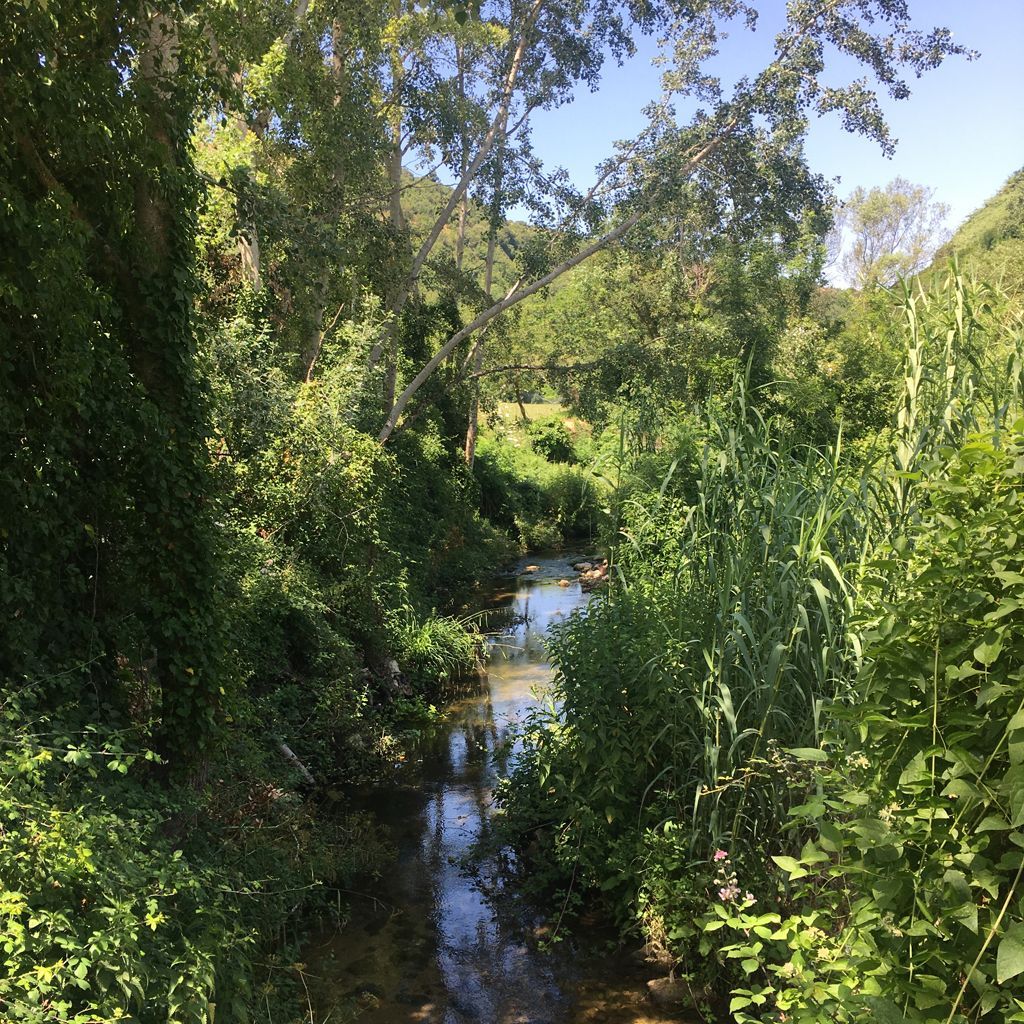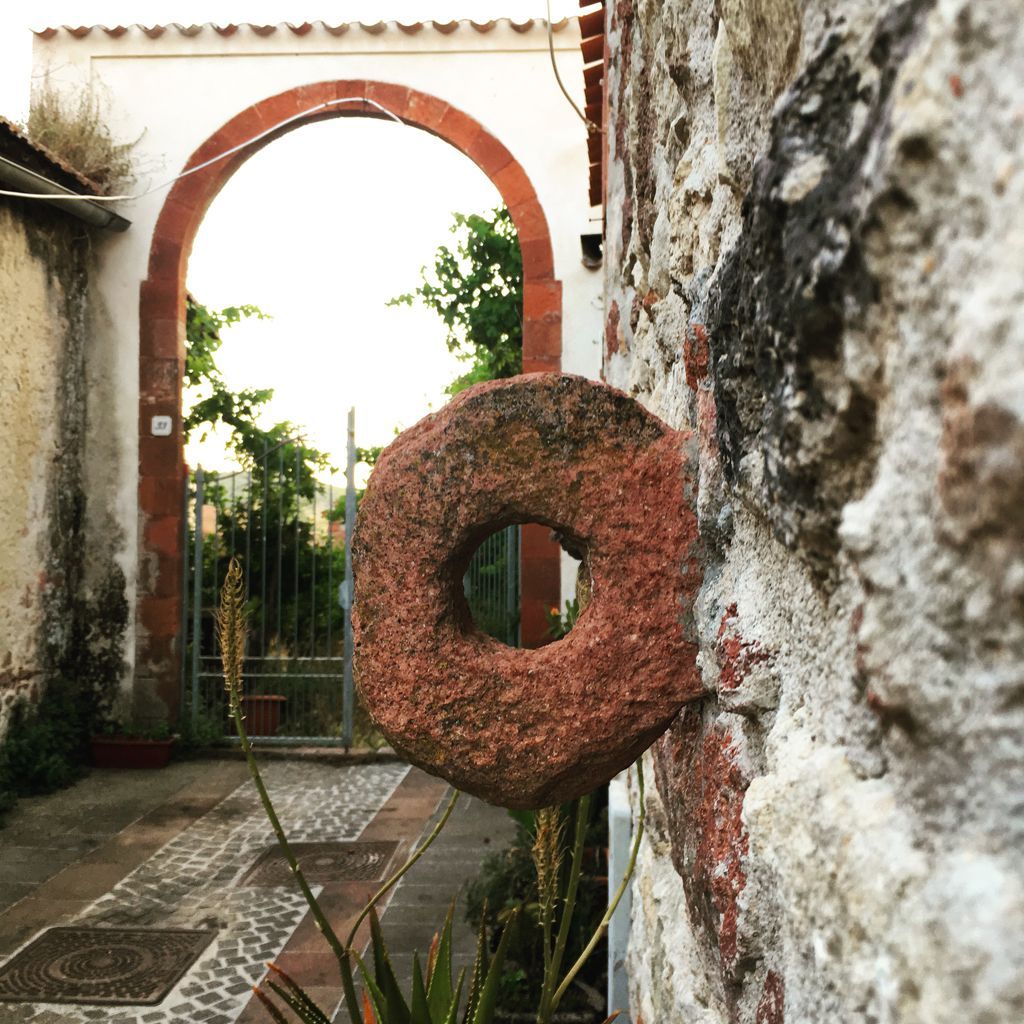
222/377: Banari
INSPIRATION

For some days the red of the “Banari trachyte” has appeared in the buildings of the neighboring villages and today I finally arrive in this village of the Meilogu, full more than the others of “red” houses!
I arrive at the main square, in front of the Town Hall, where I meet Josephine, an artist with whom I will spend the day. After the usual coffee on the outside tables in the square, we get the car to visit the area.

First stop in S’Adde Manna, the large valley, wedged between hills outside the village. Here there are several specimens of fins, the typical stone huts of the shepherds. However, these have a particularity compared to those I have already seen in Barbagia: they have the roof of stone slabs instead of bush branches, a bit like the “tholos” roof of the nuraghi. The fin that we visit, passing through the vegetation under the beating sun, is of a nice clear limestone.

We move and travel a stretch of the Cea valley. We arrive at the Romanesque church of Santa Maria di Cea. This name, in Sardinian Nostra Segnora ‘e Se (abbreviation of Seve, a disappeared village) I have already found on the Cea beach of Tortolì … who knows if they have the same meaning. Josephine tells me that this valley was once rich in water and mills. Looking at Monte Santo in the distance, I remember what the Mayor of Bonnanaro said on the waters diverted towards the large dams and now absent from all this territory.

We go back to the center and stroll through its clean and neat streets, where most of the houses have red rock mixed with white limestone, many walls also have “lorighe”, rings for tying animals, in red trachyte, and even the “funtana ‘e josso” fountain, with beautiful lions’ heads, is all red.
We arrive at the Romanesque church of San Michele, all red, inside which there is a beautiful wooden statue of the saint, held here in an altar built as an ex-voto when the cart that carried it fell down a steep staircase right outside the church. The event is also depicted in a painting.
In the afternoon, we visit the library, in the beautiful Palazzo Solinas. The librarian Pinuccio welcomes us, showing us this beautiful place. Here, incredible for such a small village, there are about 17,000 volumes. In a Sardinian folk music book I also find the score of Mariedda, the song based on a poem by my great grandfather Pasquale Dessanai. In one room there are cases dedicated to Barore Sassu nicknamed “limbamala”, an important local improviser poet.
Finally we admire the photographic exhibition on the “Train of Memory”, the important national project that consists in bringing school children to the Auschwitz and Birkenau camps, to touch with hand that horrible page of human history, and return to their lives with a different consciousness, capable of recognizing and contrasting every trace of hatred and indifference, unfortunately well present in today’s reality.

We then meet some members of the Su Concordu Banaresu choir at their headquarters. Unfortunately, several elements are missing and I can’t hear them sing, but they tell me about their activities and their repertoire, with texts by Barore Sassu and the contemporary Banarese poet Angelo Porcheddu.
But the musical moment comes soon after, when we go to the studio of the Hi-Vibes, a local reggae band. Two of the members welcome me, Giacomo and Ivan. In addition to letting me hear some of their songs, we start a jam session, me on the ukulele, which in this context sounded really great! Here the Mayor Antonio also joins us, and after we stop playing we all head to the central square for an aperitif.

Before dinner, Josephine and I take a last walk in the centre, full of narrow passages. We arrive at the “Funtana ‘e supra” fountain and at the old covered wash-house, both strictly of red stone. We walk what was once the nobles’ walk, which ends in the valley that goes to Ittiri, and from here you can admire the whole village at sunset, with the red bell tower of the parish church of San Lorenzo. We arrive right on its elegant square, where the oratory of Santa Croce is also located, and we go back home with the sun set. The red of the houses and the trachyte statues scattered here and there takes on a different color.
SOUND FRAGMENTS

SHORT SARDINIAN STORIES
In Banari I could have stumbled upon Giuseppe Carta, the famous artist of the “chili”, or Gavino Sale, historical leader of the IRS, the “Independèntzia Repùbrica de Sardigna” political party. Instead my project was intercepted by artist Josephine Sassu. Back home after the long day, Josephine shows me some of her works around the house, and some of her catalogs. I like her style, and I am struck by the ceramic works hanging on the staircase wall, the “nonomagalovirus”.
Her words explain his artistic history and philosophy better than I can say:
“I was born in 1970 in Germany to an Umbrian mother and a Sardinian father who, after four years from my birth, returned to Italy and settled in Sardinia; I brought with me an age of struggle and a great passion, favored by insularity, for airlines and the European Union.
I undertook artistic studies – always on the island, but with my nose in the air – and now, for about twenty years, I am an artist … I have passed, almost without realizing it, from Lego buildings, children’s TV, Spazio 1999, Goldrake Ufo Robot, to Penelope, Pino Pascali, Italo Calvino, the Gutai movement, Francesco Ciusa, Gina Pane and others, without too many formalities and never firing anyone.
Twenty years of work are many, at least enough to identify constants: if the corpus of my work may seem heterogeneous, in reality the subjects are almost always the same, real or fantastic animals, and even my basic philosophy, although always very serious, easily gets distracted to start playing…. Because if in war it is legitimate to confuse the enemy, in art it seems right to me to always put a mustache on one’s Mona Lisa. If nothing is created, nothing is destroyed but everything is transformed, pointless to show off!”